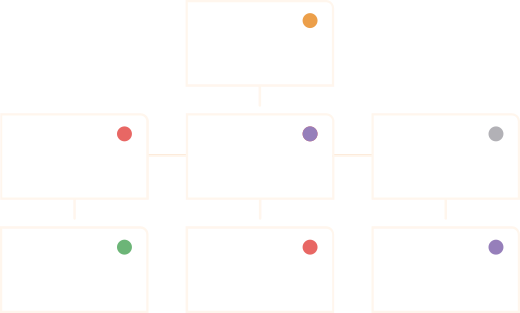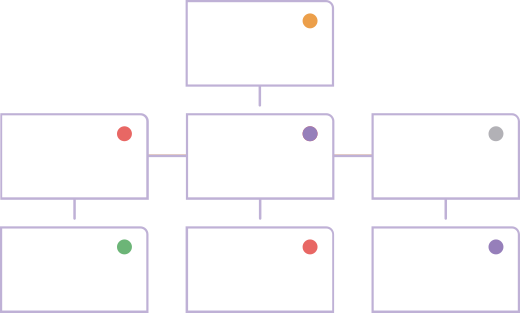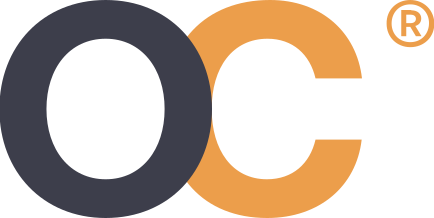
Kimberlee Henry
June 4, 2025
As companies grow beyond 100 employees, managing organizational structure becomes exponentially more complex. HR professionals need an advanced, dynamic org chart solution that can scale with their…

As companies grow beyond 100 employees, managing organizational structure becomes exponentially more complex. HR professionals need an advanced, dynamic org chart solution that can scale with their growth and help them manage both employees and positions.
HR teams at growing companies often want to visualize and manage positions, not just employees. Instead of focusing on individual employees and their performance, focusing on positions can help HR strategize about what roles they need to set up an organization for success. Therefore, HR needs software tools that can help them build and manage position-based organizational structures.
Let’s dive into the ins and outs of building a position-based organizational chart, why it’s critical to workforce strategy, and how HR teams can implement real-time position-based software solutions to facilitate company growth.
When building an organizational chart, many HR professionals focus on people first. After all, their mission is to ensure the professional and personal well-being of everyone at the company, from the newest hire to the business’ founder.
But this only captures part of the picture. What about open roles that are currently in the hiring process, or internal transfers that leave behind a position that must be backfilled? Prioritizing positions in a company chart covers all of this and more.
Positions in a company chart define the framework that enables companies to grow, pivot, and realign quickly. Unlike individuals, who may change roles or move between departments, positions serve as the foundation for workforce planning and business execution.
Position-based company charts allow you to see the full potential of your workforce. You’ll get an objective view of each team and develop a complete understanding of the positions, responsibilities, and cross-department functions that keep the company running smoothly. This helps HR professionals quickly identify incomplete or overstaffed teams, and also provides upper management with the data they need to make strategic hiring and operational decisions.
A business can’t grow if its leaders don’t have a grasp of the layout and capacity of their workforce. Knowing the people who make up a team is one thing, understanding how their positions and responsibilities contribute to company success is entirely separate.
By managing and visualizing positions independently from employees, organizations gain clarity over their current capabilities and future needs. Disconnecting positions from people helps HR professionals consider the function and value of each role with precision and objectivity.
A position-based company chart includes all job roles, including filled positions, open jobs, and previous roles that have been eliminated or consolidated. Depending on the company, it may also include spots for contractors and freelancers. The aim is to provide HR and upper management with a full picture of the company’s potential workforce, not just a moment-in-time snapshot of employees.
Plus, strategic clarity enables faster decision-making in hiring, succession planning, and organizational realignment. When an employee leaves the team, HR can look to their org chart to review the vacated position’s responsibilities, reporting relationships, and cross-team collaborations. That way, they’ll develop a better, more accurate job description that reaches the right candidates for the job, or can speak with top management regarding role elimination, consolidation, or department shuffling.
When HR teams can dynamically track and adjust positions, companies can become more agile in response to market shifts, talent needs, and organizational goals. Leaders can act quickly when new technology disrupts their industry and create dedicated positions to implement this tech in the workplace. Plus, HR will know ahead of time which teams need additional contractor or freelance support for big projects, simplifying the search for temporary talent.
Without position control, growth can become reactive and inefficient. HR teams could be left scrambling when employees leave the company, trying to understand the role they left behind and the required skills for potential candidates. Companies stagnate without a full understanding of their workforce’s hierarchy and capabilities, and will be stuck trying to keep up with innovators in their industries.
To properly manage and scale a team, HR professionals must have full transparency around the positions in a company chart, how they’re connected, and which company functions correspond to which role. A lack of position visibility can lead to multiple organizational challenges.
When open positions are not tracked, HR teams set themselves up for confusion, frustration, and hiring process delays. Sure, there’s likely a record of the roles that have been recently vacated through employee departures or internal transfers, but what about open positions that fell through the cracks and were never filled?
When a team is consistently running into operational issues, burnout, or missed deadlines, that’s a red flag to HR that they need additional support. But with a position-based company chart, that red flag will be raised far before the team is in crisis! HR professionals will have a complete history of all the positions on the team, even long-defunct ones, and know what the team needs before they need it.
Without visibility into planned and open positions, HR teams often inadvertently shift their hiring efforts from being proactive to reactive. These two types of hiring practices include:
Reactive hiring is the most common hiring practice, but it often leads to rushed decisions. When an HR team is on the clock to hire a candidate, they may overlook things like soft skills and culture fit, or speed through interviews and not get a full picture of a candidate’s skills and experience. This can lead to high turnover rates, redundant responsibilities, and an increasing need for contractors to backfill positions.
To appropriately allocate a company’s budget, you need a robust, up-to-date organizational chart that includes actual and budgeted salary information, ideally by position.
Without this, budget forecasting and planning become unreliable and chaotic. Leadership teams will, by default, operate without a clear view of organizational capacity and headcount needs. They may do this unknowingly, risking financial misalignment and growth stagnation. Companies can’t fill open positions and properly support teams if there isn’t the budget to bring on new hires.
Static org charts and spreadsheets may look clean in presentations, but they break down quickly in real-world use, in particular when displaying position. As organizational structures shift, these formats need to be manually updated. And, if positions are not consistently updated , leaders and teams are working from inaccurate data.
Tools like Excel or Visio are still widely used for org charts, but they weren’t designed for active position management. Spreadsheets become complex and error-prone, and PowerPoint org charts while polished, lack real-time editability.
Even storing these charts in shared drives creates issues with collaboration and version control. Without a dynamic, centralized system, HR teams struggle to manage position data efficiently, leading to hiring delays, leadership confusion, and internal miscommunication.
The larger a team is, the more time-intensive it is to manage from an HR perspective. Therefore, real-time software that creates position-based charts can save businesses and support HR teams valuable time while assisting them in their most vital responsibilities.
The key to understanding your workforce is to build a complete map of all positions, open, filled, eliminated, temporary, and planned roles alike. Dynamic organizational chart software that automates and updates position-based charts can provide immediate insight into which positions in a company chart are filled by an employee and which are still available.
Plus, these software solutions often allow for total customization, giving HR teams the ability to color-code vacant roles by status. Anyone viewing the chart will instantly know which roles they’re currently hiring for, which are being filled within the organization, which are on pause, and which are intended for freelancers or contractors.
This level of transparency and visibility provides HR and upper management with valuable information when it’s time for annual budgets to be allocated. They’ll get a picture of how much should be set aside for hiring processes and where to expect new hires to join the team. HR can also spot teams that require more resources and create contingencies within the organization or plan to bring on contractors for extra support.
With dynamic position visibility, HR moves from being an administrative function to becoming a strategic partner in organizational growth and workforce alignment. They can move past reactive hiring practices and transition to a proactive approach, allowing them to build a pool of promising talent to strengthen the business. Not only does this speed up future hiring processes, it also helps HR professionals hire with confidence and work quickly when new technology or industry innovations require new positions.
When a company restructures, HR will be ahead of the curve. A real-time, position-based org chart can instantly adapt to the new hierarchy and reshuffle its format to fit the new team. And because it’s not people-based, the reporting relationships, role responsibilities, and collaborative functions across the chart will update automatically.
See How to Manage Positions in a Company Chart
Watch how OrgChart helps HR teams visualize open roles, align org strategy, and adapt to changes, fast.





With real-time, position-based org chart software in their toolkit, HR professionals can set teams up for success. To ensure you’re doing all you can to support your team, follow these best practices for managing positions in a company chart.
When reviewing business goals and initiatives, top-level management must bring HR into the conversation to ensure all roles are supporting company activity. Together, they can determine which roles are redundant, how existing roles connect to company objectives, and where new positions can aid teams in fulfilling their goals.
Building a position-based org chart is all about proactivity and strategy. Regularly reviewing your company chart to identify redundant, missing, or outdated positions allows you to proactively optimize headcount and improve team efficiency. Plus, you may find opportunities for cross-department collaboration that could enhance productivity and streamline internal communications.
As soon as your company is set up on your real-time org chart software, your first step must be enabling HR platform connections. Integrating HRIS, ATS, and performance systems within your company chart ensures a consistent, reliable source of workforce data for all employees. HR and upper management can use the chart for enhanced staff planning and analysis, while other employees can refer to the chart when collaborating with other teams or searching for departmental decision-makers.
Managing positions at scale requires more than manual spreadsheets and static visuals, it requires real-time insight, strategic alignment, and the ability to adapt quickly. OrgChart empowers HR teams to take control of their workforce structure with dynamic, position-based charts that evolve as your company does. Whether you’re scaling, restructuring, or future-proofing your workforce, OrgChart is your strategic partner in turning organizational complexity into clarity.
Book a personalized demo and discover how OrgChart helps HR lead with precision, visibility, and confidence.

Managing Positions in a Company Chart: Strategies for Modern HR Teams…
As companies grow beyond 100 employees, managing organizational structure becomes exponentially more complex. HR professionals need an advanced, dynamic…
Read Article
Restaurant Hierarchy Chart: Structure & Roles…
Restaurants are arguably the busiest businesses out there, with servers, cooks, managers, and executives working hard to ensure every guest has a stellar…
Read Article
Healthcare Organizational Chart: Structure, Examples & How to Build One…
Explore the power of People Analytics. Unlock data-driven HR strategies to optimize your workforce with our tools.…
Read Article